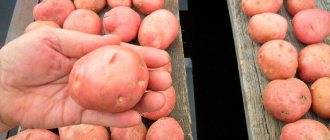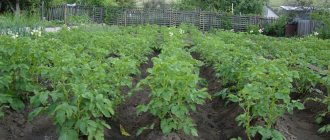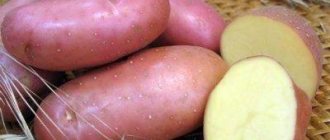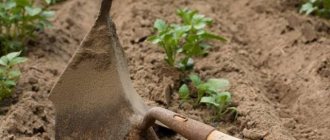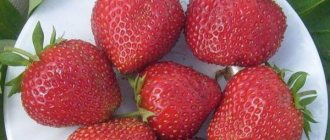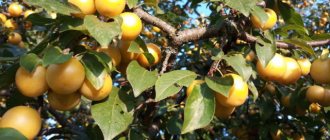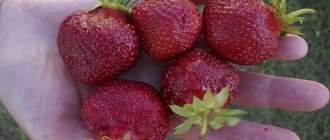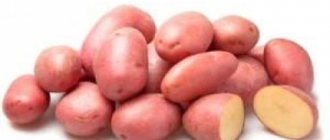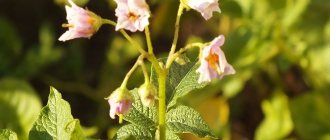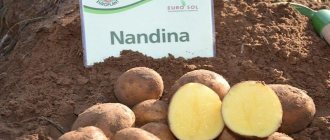Description and characteristics of the variety
Seed potatoes Krepysh are included in the category of mid-early table varieties. Domestic potatoes belong to the breeding group of the All-Russia Research Institute named after A.G. Lorja. The variety has been included in the State Register since 2005. The Shrminsky-2 standard and the hybrid numbered 2953-34 were taken as the basis.
The ripening period occurs on the 60-70th day after the appearance of the first shoots.
Harvesting of young tubers is possible on the 45-50th day (this is the first digging), the second time the potatoes are dug up on the 55-57th day.
Potatoes are well adapted to drought, heat, and sudden cold snaps. It bears fruit consistently in different climates from south to north. Recommended territories and areas for cultivation:
- Far Eastern;
- Central;
- Central Chernozem;
- Northwestern;
- Northern.
Plants have an average length of tops (50-65 cm), the arrangement is semi-erect. 15-20 high-quality uniform tubers ripen in 1 potato nest.
What is useful to know about tubers:
- average weight 80-100 g;
- starchiness below average - 10-12%;
- yellow skin with a few eyes;
- the center is creamy;
- the texture is dense.
The tubers have excellent taste and consumer properties. Cookability is low, potatoes are not suitable for mashed potatoes. But it is successfully used for boiling (in its skin, in slices), frying, baking, stewing with other vegetables.
Characteristics of strong potatoes
The characteristics of the Krepysh variety include a botanical description of the bush and root crop, yield and scope of application, advantages and disadvantages.
Botanical description of the bush and root crop
The bushes are low, form leaves of bright green color, up to 6 cm long, the edges have a characteristic waviness. Blooms profusely with red flowers with a purple tint. Krepysh belongs to the mid-season varieties; the growing season lasts 80–90 days from the moment of planting.
Root vegetables with light brown skin. There are many peepholes on it, 2–3 mm deep. The pulp is light yellow and contains 11% starch. Potatoes retain their shape when cooked. All tubers have a round, elongated shape and the same size. The weight of the fruit ranges from 80 to 110 g.
Productivity of the variety and scope of application of the fruits
The yield of the Krepysh variety is average; 10–12 tubers are harvested from one bush. From one hectare of land they dig 300 - 350 centners of potatoes. Under favorable growing conditions, the maximum yield is 380 centners per hectare.
Potatoes are used for personal consumption, making soups, French fries, frying and baking. It is grown on an industrial scale and for sale.
Main advantages and disadvantages
Krepysh potatoes have their advantages and disadvantages. The benefits include:
- early ripening of fruits;
- marketable condition;
- transportability;
- high taste qualities;
- low starch content;
- preservation of shape during cooking;
- resistance to potato blight;
- ease of care;
- drought resistance.
Disadvantages include susceptibility to late blight infection and attack by the Colorado potato beetle.
Landing
A month before the planned planting, the tubers are brought into the heat (the temperature in the room is maintained within 14-16 degrees). At a temperature of 18-20 degrees, the shoots will grow to the desired length in 2 weeks. The seeds are laid out in a well-lit and ventilated place.
When the seedlings reach 1.5 cm, the potatoes can be planted.
Farmers are advised to treat the seeds with an activator (Epin, Bioglobin, Poteytin, Kornevin) the day before planting. To protect against infectious pathogens, tubers are soaked in a solution of Baktofit, Acrobat.
During autumn plowing, the plot is dug up to a depth of 30 cm, organic fertilizers are added (compost 7-8 kg per 1 m2), ash (100 g per 1 m2). The following components are poured into heavy soil per 1 m2:
- 3-3.5 kg of peat;
- 3-4 kg of sand;
- 6-8 kg of rotted humus.
During spring harrowing, add superphosphate 30 g per 1 m2 and potassium chloride 10-15 g per 1 m2.
When planting, complex compounds and mineral mixtures can be added to the holes, but not organic matter (because of this, the tubers may be watery or bitter).
The beds are located from north to south. A distance of 30-35 cm is maintained between the holes, and the row spacing is 60 cm. The depth of the holes varies depending on the ground. In light soil they plant 10-12 cm deep, in heavy soil holes are dug 5-6 cm deep.
Rules for harvesting and storing crops
Harvesting is carried out when the tops turn black and dry out. This occurs 80–90 days after planting the seed. The tubers are dug up using a shovel. Then place them in a dark, cool, ventilated place for 1 - 2 weeks to dry.
Next, the finished potatoes are packaged in fabric bags and breathable boxes. Store in a cool, dark place until the start of the next season. The room temperature should be 4 – 6 °C. Large, healthy root crops are set aside for seed.
The sturdy frame is well stored and retains its appearance, and can easily withstand transportation.
Growing and care
Crop rotation is observed on the field - potatoes are not planted in the same place for more than 2 years in a row. Precursors include cruciferous, root, salad, melon and onion crops. It is useful to sow oats, rye and other winter green manures for the winter. After the snow melts, the greenery is buried in the ground.
The bushes are watered 2-3 weeks after germination. In total, during a season with moderate precipitation, 2-4 moistenings are sufficient. Subsequent waterings occur during the flowering phase. The moisture level of the beds is checked at a soil depth of 10-15 cm. The liquid rate is 2-3 liters per plant. When watering, try not to get it on the tops; water is poured between the rows or under the base of the bush (to avoid late blight).
What are the nuances of applying fertilizers:
| Feeding time | 10 l solution | How much do you contribute per 1 bush? |
| Tops length 18-22 cm | 20 g saltpeter 20 g saltpeter and 20 g potassium sulfate 20 g urea | 0.5 l |
| Beginning of flowering | 15 g Kemira 10 g potassium chloride 20 g superphosphate | 0.5 l |
| The height of tuber setting | 15 g Mag-Bor 15 g potassium sulfate | 0.5 l Mag-Bor 0.05 l (spray plants) |
Bushes are hilled 2-3 times. When the tops grow by 15-20 cm, the procedure is carried out for the first time. The height of the embankment is 10-15 cm. Then hilling is repeated at intervals of 14-20 days. Plants are sprinkled to 2/3 of the height, leaving 3 leaves free on top. The frequency of loosening is 1 time every 10-12 days. Tubers are formed no deeper than 16-17 cm, the soil is loosened to a depth of 4-5 cm.
Features of agricultural technology of the variety
It is better to plant in mid-May. When all the spring frosts and weather anomalies after winter have passed, you can begin full processing. You can add straw or hay to the soil to increase tuberization of potatoes. In order for the yield to be as high as possible, you should immediately take care of the correct planting conditions. You need to choose the best lit area possible; this variety loves sun and warmth. The soil must be fertile and the water supply to the potatoes must be plentiful.
Advice!
Select soil with groundwater. Potatoes will receive more nutrients and minerals, and a good harvest is guaranteed!
Harvest in August-September. Before placing the crop in the cellar for storage, it is recommended to dry the tubers in shady places. If the potatoes are not sufficiently dried, this can lead to the development of pests and pathogenic parasites, fungal diseases, and tuber diseases. Accordingly, taste will also reduce its ratings.
During planting, you must adhere to intervals of 60 centimeters from each hole. Here are a few rules for growing Krepysh potatoes:
- planting material must be treated to prevent cultural diseases;
- we must remember to spray with a growth regulator;
- do not forget about loosening;
- It’s better to check the soil to make sure it doesn’t have an abundance of moisture, in which case it should be planted on ridges or ridges;
- It’s also worth keeping an eye on the temperature: the soil should warm up to at least +8 °C.
Care is an important part of tuber growth. All conditions must be observed and maintained for the harvest to be tasty. Even when potatoes are unpretentious to them, like the Krepysh variety, you should not forget about the following things when caring:
- Before loosening the rows, it is necessary to fertilize with plant and poultry fertilizers. Usually the period is two weeks after planting.
- We must not forget about hilling, because inexperienced gardeners miss this and get a poor-quality harvest with small tubers. Loosening can be done immediately after germination if the soil is heavy (the amount depends on the soil and weeds around the bushes).
- Hilling the rows should be done in one direction.
- Perform three fertilizings with mineral fertilizers in one season.
- If the soil is properly fertilized and loosened at the right time, then weed plants grow twice as fast as young shoots. This leads to the loss of useful substances. To avoid this, you need to regularly weed the beds: when the tops begin to bloom, no weeds will prevent the tubers from developing.
Advice!
From mineral fertilizers, choose those where the percentage of nitrogen content is normal and not increased. And it’s even better if they are copper-containing drugs.
Harvest for the first time literally after 45 days. The result pleases with its speed, appearance, and taste, so it’s a pleasure to assemble Krepysh. After harvesting, the main thing is not to forget to dry the potatoes and separate the seed material. It is necessary to ensure the most favorable storage conditions, otherwise the fruits will simply begin to grow further later, when it is no longer possible to develop them further (any dark room, for example, a basement, with a temperature of +1 - 4 ° C will do).
Irrigation should not be done immediately and constantly. Potatoes only need it during the period of bud setting and the flowering process itself.
Advantages and possible disadvantages
One of the advantages of Krepysh, which is also the main difference from other super-early varieties, is the ability to be stored for a long time at early ripening periods. Tubers do not wither or rot if properly stored until spring.
- Other advantages of the variety:
- early maturation;
- smooth fruits with clean skin;
- high productivity;
- good taste;
- tolerates transportation well;
- not susceptible to diseases and pests;
- drought resistance;
- not capricious to growing conditions.
The disadvantage is the need to hill up the bushes more often than other varieties.
Advice from experienced gardeners and reviews about the Krepysh variety
Advice from experienced farmers that will help you get a high-quality and abundant harvest:
- Plant potatoes only in well-warmed soil, otherwise the tubers will rot.
- Change the location for planting potatoes every year.
- Be sure to spray the bushes to prevent diseases and pest attacks.
- Keep an eye on watering. Do not allow water to get on the leaves - this will lead to the development of late blight and the death of most of the crop.
Krepysh is a young variety that has already become a favorite of many gardeners , which is confirmed by positive reviews.
The benefits and harms of iceberg lettuce || Iceberg lettuce in folk medicine
Valentina, Vologda region. : “I grow potatoes at the dacha, a couple of years ago I decided to plant Krepysh and was not disappointed. What attracted me most was the variety’s ability to tolerate short-term drought, because I can only come to the dacha once a week. The yield is encouraging - we have more than enough for two large families.”
Nikolay, Tver : “Strong is a telling name for this variety. The tubers are large, beautiful, the harvest is rich - enough for yourself and for sale. I store potatoes in the cellar, but in mid-April it becomes humid there, so I move the leftovers to a drier place. I hill up with a mini-cultivator - it’s very convenient.”
Potato Lapot: champion among ancient varieties
For commercial cultivation, 2-3 times fertilizing with a mineral complex is sufficient in addition to standard pre-planting fertilizing.
Recommended for planting in the Central and Far Eastern regions of Russia, feels great at home in Belarus, and in Ukrainian Polesie, Transcarpathia, and the southeast. One of the varieties, suitable for large-scale cultivation in large agricultural farms for sale, is good for both the farmer and the gardener due to the cancellation of yield, excellent taste, and long shelf life in cool storage.
Are there any downsides?
The disadvantages include the following:
- Short period of rest - store at t +7 C - cold storage;
- Abnormal heat and minimal watering have a bad effect on the harvest, and sometimes crop failures occur. In dry areas with a risk of interruption of irrigation, it is better not to take risks.
- Sufficiently soft fiber is often a plus, but for those who like a coarse, crispy crust, it is not significant, but a minus.
It is worth noting that over many years of life, the Lasunok potato has received excellent reviews: it is known for its high yield - up to 620 c/ha, the Colorado potato beetle does not take it, is resistant to diseases and pests, and is not too demanding on agricultural technology
What is important is simply excellent taste. Grow for health!
If you are looking for a variety that is productive, tasty and does not require dancing with a tambourine in a potato field, you have found it. Tested by time and large agricultural enterprises, not afraid of the Colorado potato beetle, the insidious late blight and blackleg - you are on target. Meet the Lasunok potato, the whole truth about the variety that has become a classic in potato growing.
